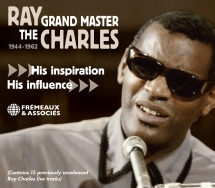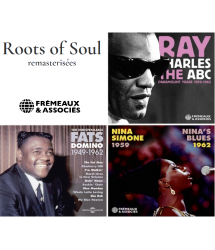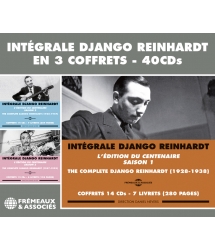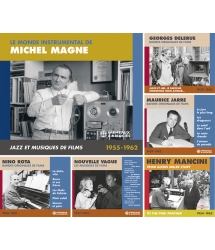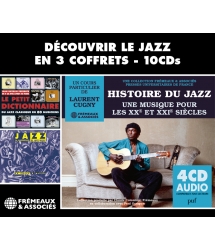-
The result is an excellent recording by Norman Darwen
Catégories : Article de presse ( Article de presse )Moune De Rivel is one of the most important figures in recorded Antillean music, having first appeared on 78 rpm discs in 1944. She recorded this set in 2000, and there is still a great passion and joie-de-vivre to her voice. She remakes many of the great biguines and folksongs of Guadeloupe - some of which were written by Moune's mother, Fernande De Virel, others by friends and acquaintances - and is accompanied by an extremely sympathetic band. Try to hear her earlier recordings - also available from Frémeaux - as her voice was more flexible then, but for this CD flexibility gives way to experience. The exchange is a fair one and the result is an excellent recording." Norman DARWEN- AMAZON.CO.UK
-
Des chefs-d'oeuvre d'amérique latine par Trad Mag
Catégories : Article de presse ( Article de presse )Un beau coffret qui s'inscrit dans la politique du label Frémeaux et Associés de rééditer des enregistrements introuvables. Le champs d'étude de cette publication est vaste. Elle regroupe des "chefs-d'oeuvre d'amérique latine", enregistrés au Mexique, à Cuba ou à Porto Rico entre 1933 et 1956 (la fameuse règle des 50 ans de pouvoir publier librement des enregistrements anciens). La musique dominante est le boléro, pour une esthétique de "variète latino" rétro. Une musique qui fait danser tout un peuple, de La Havane à Mexico, et des interprères de légende parfois oubliés aujourd'hui comme Pedro Vargas ou Xavier Cugat. Jean-Baptiste VINSARD-TRAD MAG
-
Un document historique et ethnographique exceptionnel par Le Journal du médecin
Catégories : Article de presse ( Article de presse )Paul-Emile Victor, ce vagabond des Pôles avait enregistré en 1956 un document historique et ethnographique exceptionnel : les récits sur la grande famine qui toucha les Esquimaux du Groenland en 1882 et 1883. Un récit collecté auprès des Ammassalimiout peuple auprès desquels Victor et trois autres jeunes savants passent un hiver à Tassiussak au Groenland en 1934. Grâce à sa liaison avec Doumidia, une jeune Esquimaude, il apprend très vite la langue inuit (on le voit, l'amour a bien une fonction) et se fait raconter les histoires autochtones. Nourri de cette culture et marqué par le traumatisme constitutif de l'histoire esquimaude que sont les grandes famines du siècle dernier, il assemble les récits et témoignages qui composent cette Grande faim. Un récit terrible et qui donne la chair de poule (pas seulement à cause du froid, d'ailleurs) malgré la voix imperturbable et le timbre de granit du grand navigateur. A croire que lui aussi est prisonnier des glaces de l'émotion. B.R.-LE [...]
-
La quintessence d'une voix par Blues Again
Catégories : Article de presse ( Article de presse )Cinquième et ultime volume de son intégrale. Vingt chansons pour poursuivre le découverte de cet artiste majeure du gospel blues. Mais n'avoir que ces vingt chansons est d'un frustrant! Mahalia Jackson interprète quelques titres enregistrés entre 1954 et 1955. A écouter la mélancolique "The Treasures of love", l'énorme succès d'alors "A Rusty Old Halo" et les deux gospels songs que sont "Walk Over God's Heaven" et "Jesus Met The Woman At The Well", on constate que son registre est aussi étendu que les plaines du Midwest. La compilation est faite de telle manière qu'on passe de la mélancolie à la ferveur sans coup férir. Et comme toute diva du gospel blues, l'ouverture des glandes lacrymales n'est jamais trop éloignée, surtout à l'écoute d'une perle telle que "Somebody Bigger Than You And I". Que sa voix vous prenne aux tripes ou autre part, ces vingt chansons vous offrent un bon aperçu de ce que peut être toute la quintessence d'une voix et d'une âme vouée au gospel blues. Et l'en [...]
-
Ces instrumentistes hors pairs sont de vrais jazzmen et ça s'entend par Etudes T
Catégories : Article de presse ( Article de presse )"Quelle bonne surprise que ce nouveau disque du trop discret Jacques Bolognési, accordéoniste (On se souvient de sa participation à Paris musette sur le même label au début des années 90 et des deux beaux disques du Bolovaris avec Francis Varis et Tiboum Gagnon) mais aussi tromboniste, arrangeur et sideman recherché. A ses côtés, Marc Fosset, guitariste qui fut associé aux lames de Marcel Azzola au sein du trio Azzola Caratini Fosset il y a une vingtaine d'années. A la contrebasse, selon les titres, Pierre-Yves Sorin ou Jean-Luc Ponthieux, tous excellents musiciens au curriculum vitae grand comme le bras ; on parle (trop) peu de ces modestes alors qu'ils volent bien plus haut que ceux régulièrement encensés dans le jazz français. A part une relecture sensible et poétique de " Little child ", beau thème de Wayne Shanklin (dont Eddie Constantine fit un tube " L'homme et l'enfant ", sur des paroles de René Rouzaud), que des compositions originales à l'inspiration variée : 4 de Bologn [...]
-
De quoi s'instruire! par Le cri du coyote
Catégories : Article de presse ( Article de presse )Tout le monde associe un type musical à l'expression musique irlandaise, avec un a priori d'authenticité sur un folklore spécifique qui a essaimé aux USA. On évoque une instrumentation, un répertoire, des modes mélodiques immédiatement reconnus, mais une analyse précise devient vite un casse-tête! Gérard Herzaft (dans un livret copieux) a le grand mérite de raconter les étapes du processus évolutif qui mène de ce qu'est la tradition et ses méthodes de diffusion, ses adaptations et ses récupérations par le commerce et les musiciens jusqu'à une sorte de folk revival qui influence encore la musique aujourd'hui et nous sert de référence. L'étude de la filiation américaine, contées ici avec ses années formatives à partir des premières traces importantes enregistrées, permet de découvrir un nombre impressionnant de musiciens et de mieux voir comment a fonctionné ce va-et-vient entre amateurs et diffuseurs. De même, les rapports mêlés ou distants entre irish music et country music (dont [...]
-
Un jazz essentiel par La Revue des médiathèques et collections musicales
Catégories : Article de presse ( Article de presse )Ce coffret de deux CD's rend compte du creuset d'influence et de création jazzistique que fut le quartier de Harlem et ses multiples club de jazz, aujourd'hui mythiques: l'Apollo, le Cotton Club, etc... Trente-huit titres mémorables d'un jazz essentiel qui fut longtems l'apanage de Harlem: de fats Waller à Duke Ellington, de Teddu Wilson à Count Basie, de Willie Smith à Al Cooper, de Cab Calloway à Louis Armstrong. Une bien belle ballade. Jacques VAZEILLES-REVUE DES MEDIATHEQUES ET COLLECTIONS MUSICALES
-
Le légendaire personnage par La revue des médiathèques et collections musicales
Catégories : Article de presse ( Article de presse )Lu par Henri Vibert. Enregistrement historique de 1956. Le légendaire personnage Tartarin de Tarascon marque tous les esprits : haut en couleur, volubile, burlesque et surtout parodiant (déjà!) le méridional bon teint... Ce texte inoubliable met aussi en perspective une époque qui est le contexte des agissements de Tartarin : la fin du XIX ème siècle et la mutation engendrée par la révolution industrielle, la différenciation entre le monde paysan et le monde industriel et l'impact de cette révolution sur la politique. Des racines historiques qui peuvent servir à expliquer la force du libéralisme sur l'organisation politique de notre pays aujourd'hui. A lire et à entendre avec réflexion et légèreté. Lucas FALCHERO-REVUE DES MEDIATHEQUES ET COLLECTIONS MUSICALES



